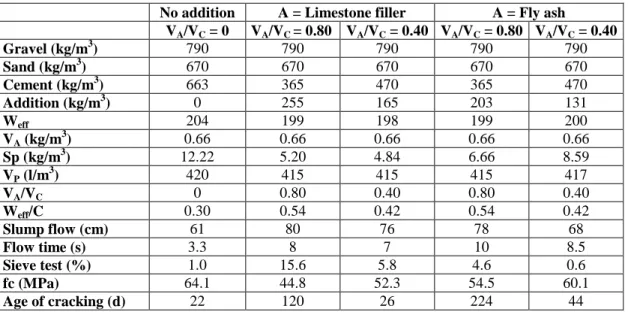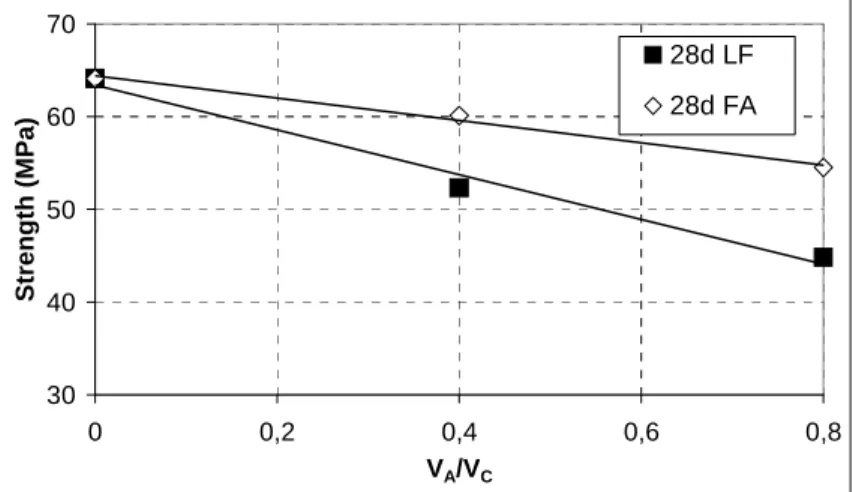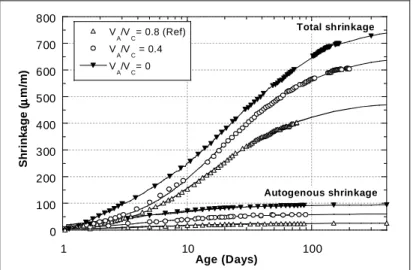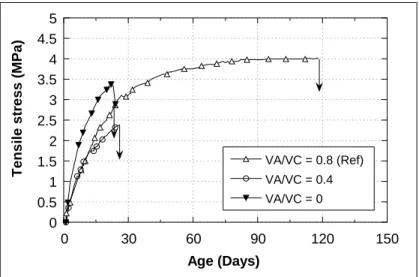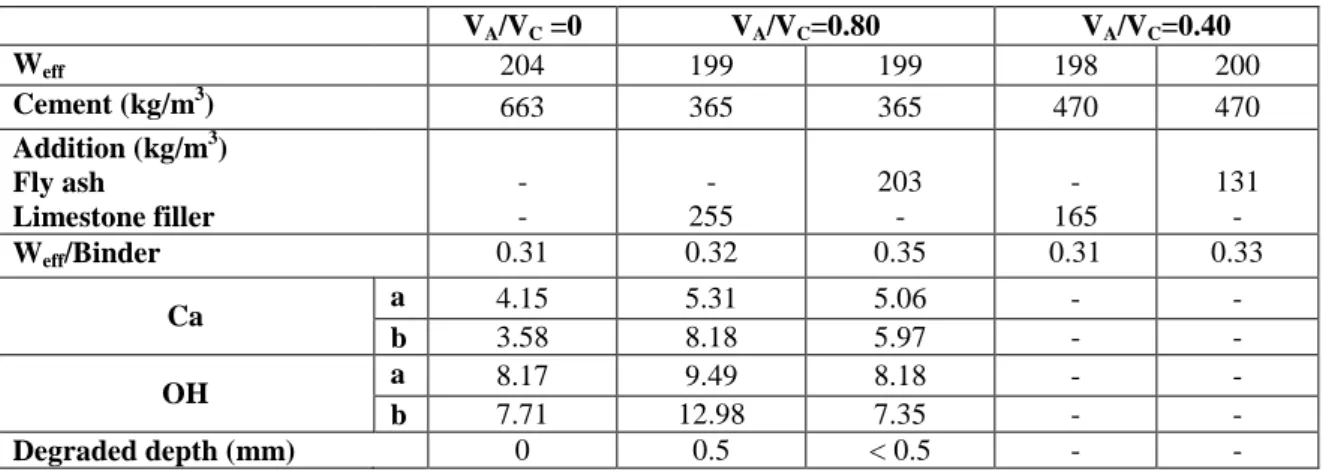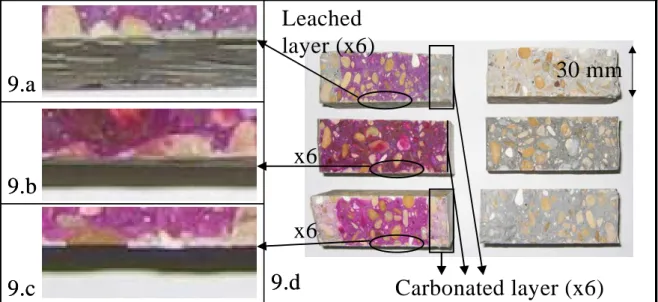HAL Id: hal-01008100
https://hal.archives-ouvertes.fr/hal-01008100
Submitted on 14 Dec 2017HAL is a multi-disciplinary open access archive for the deposit and dissemination of sci-entific research documents, whether they are pub-lished or not. The documents may come from teaching and research institutions in France or
L’archive ouverte pluridisciplinaire HAL, est destinée au dépôt et à la diffusion de documents scientifiques de niveau recherche, publiés ou non, émanant des établissements d’enseignement et de recherche français ou étrangers, des laboratoires
Effect of Mineral Additives on Some of Durability
Parameters of Concrete
Muhammad Khokhar, Emmanuel Rozière, Frédéric Grondin, Ahmed Loukili
To cite this version:
Muhammad Khokhar, Emmanuel Rozière, Frédéric Grondin, Ahmed Loukili. Effect of Mineral Ad-ditives on Some of Durability Parameters of Concrete. 2nd International Conference on Advances in Cement Based Materials and its Application to Civil Infrastructure, 2007, Lahore, Pakistan. �hal-01008100�
EFFECT OF MINERAL ADDITIVES ON SOME OF DURABILITY
PARAMETERS OF CONCRETE
Muhammad Irfan Ahmad KHOKHAR, Emmanuel ROZIÈRE, Frédéric GRONDIN, Ahmed LOUKILI
Institut de Recherche en Génie Civil et Mécanique – GeM Ecole Centrale de Nantes
1 rue de la Noë, BP 92101 44321 Nantes cedex 3 France
Corresponding author: ahmed.loukili@ec-nantes.fr
Abstract
Reducing the greenhouse gas emissions is essential for sustainable development particularly the carbon dioxide (CO2). The manufacturing of Portland cement is a highly energy-intensive
process requiring about four Giga Joules (4GJ) of energy per tonne of finished product. The less energy intensive materials being sought are industrial by-products that are easily available, require little or no pyro-processing and have inherent or latent cementitious properties. Reducing the cement content in concrete by 40%-60% contributes to reduce CO2
emissions. A part of the cement content can be replaced by fly ash and other supplementary materials and high range water reducing admixtures. Use of additive minerals improves pozzolanic reaction, micro-aggregate filling and concrete durability. Long term investigations have confirmed that cements containing slag and condensed silica fume impart better resistance to formation of large pores of cement clay or cement–silica fume paste systems, consequently to a decrease in the permeability. The present paper brings the past, present and expected future in the field of concrete with additive minerals using less cement. Studies have been performed on the durability of these concretes under different environmental conditions. Parameters like compressive strength, shrinkage, effects of carbonation and acid attacks have been measured.
1. INTRODUCTION
The construction industry must address certain consequential issues in the process of achieving sustainable development as it consumes considerable resources and has a significant impact on the environment. Carbon dioxide (CO2) is a by-product of a chemical
conversion process used in the production of clinker, a component of cement, in which limestone (CaCO3) is converted to lime (CaO). CO2 is also emitted during cement production
by combustion of fossil fuel and is accounted for elsewhere and making one tonne of cement
produces approximately one tonne of CO2.Further, the manufacturing of Portland cement is a
highly energy-intensive process requiring about four Giga Joules (4GJ) of energy per tonne of finished product. One of the most significant activities stressed by the engineers and scientists related to concrete industry aims at a high percentage of replacement of clinker in cement with secondary raw materials, with the possibility of improvement of cement characteristics and durability of concrete. With this kind of approach, the consumption of natural raw materials, thermal and electric energy, together with the reduction of CO2 emissions, are
decreasing [1]. The less energy intensive materials being sought are industrial by-products that are easily available, require little or no pyro-processing and have inherent or latent cementitious properties and are called as supplementary cementitious materials or mineral additives. Mineral additives are available in large quantities that can be used to replace portland cement in concrete. These include fly ash, granulated blast-furnace slag, silica fume, natural pozzolans, rice-husk ash, and metakaolin.
These mineral additives if used in combination with high range water reducing agents (HRWRA) can lead to economical high performance concrete with enhanced durability and by reducing cement content in mixture proportioning contribute to CO2 emissions reduction
[2]. These mineral additives are added in the cement as extra binder materials and the benefits of using these materials in terms of workability are well established [3-5]. Some studies have been performed to determine mechanical properties, thermal properties, transport mechanisms and the influence of mineral additions on the durability of blended concrete [6-11].
The project suggested here aims at studying the impact of the massive mineral additions on the strength, workability and permeability of concrete to assess their durability. The additions like the slag of blast furnace and the fly-ash are known to have rather slow kinetics of hydration and consequently delay the time setting and the hardening of concrete. However the short-term strength is a major parameter of the management of the building sites. Results of this study should make it possible to promote the use in high quantities of mineral additions, directly in the manufacturing of concrete and either only as addition in cement. From an economic point of view, that means to develop industrial by-products. That passes by the standardization of the concrete to high proportioning in additions [12].
Tested concretes in this work contain a high volume of mineral additives. First of all, the experimental program is detailed with the description of the tested materials and of the experimental procedure. Then, results on the carbonation test and on the acid attack are presented and compared to ordinary concrete.
2. EXPERIMENTAL PROGRAM
2.1 Mixtures compositions and materials
Two sets of mix were prepared along with a reference mix called Ref (VA/VC = 0), with VA
the volume of additions and VC the volume of cement. The concrete constituents are
presented in Table 1. In the first set of mix, the addition/cement volume ratio (VA/VC) of Ref,
equal to 0.8 was used and in the second set, VA/VC was reduced to 0.4, keeping the paste
volume constant. Limestone filler (LF) and fly ash (FA) were used for each value of VA/VC to
investigate the influence of different addition type. For each mixture, super plasticizer content was adjusted in order to achieve a slump flow between 60 and 80 cm and to avoid segregation, which was controlled using the sieve test. The concrete mixtures are described in Table 2.
Table 1: Materials of the concrete mixtures Gravel 3/8 mm rolled gravel
Sand 0/4 mm sea sand
Cement CEMI 52.5 type ; 0/100µm ; Blaine = 405 m2/kg Limestone filler (LF) 0/100µm ; Blaine = 397 m2/kg
Fly ash (FA) Median diameter: 14 µ m ; SiO2: 53 %
Table 2: Compositions and properties
No addition A = Limestone filler A = Fly ash
VA/VC = 0 VA/VC = 0.80 VA/VC = 0.40 VA/VC = 0.80 VA/VC = 0.40 Gravel (kg/m3) 790 790 790 790 790 Sand (kg/m3) 670 670 670 670 670 Cement (kg/m3) 663 365 470 365 470 Addition (kg/m3) 0 255 165 203 131 Weff 204 199 198 199 200 VA (kg/m3) 0.66 0.66 0.66 0.66 0.66 Sp (kg/m3) 12.22 5.20 4.84 6.66 8.59 VP (l/m3) 420 415 415 415 417 VA/VC 0 0.80 0.40 0.80 0.40 Weff/C 0.30 0.54 0.42 0.54 0.42 Slump flow (cm) 61 80 76 78 68 Flow time (s) 3.3 8 7 10 8.5 Sieve test (%) 1.0 15.6 5.8 4.6 0.6 fc (MPa) 64.1 44.8 52.3 54.5 60.1 Age of cracking (d) 22 120 26 224 44 2.2 Experimental procedure
Compressive strength was determined at 2, 7 and 28 days on 11 x 22 cm cylinders, stored in a room at 20°C and 95% of relative humidity (RH). The elastic modulus was determined at 28 days from compressive tests on the same cylinders, loaded at 30 % of the peak value.
Free shrinkage was determined on 7 x 7 x 28.4 cm concrete prisms, kept at 20°C and 95% RH during 24 hours after mixing. From the age of 1 day, total shrinkage (i.e. drying + autogenous) was measured using LVDT sensors, in a room at a temperature 20±2°C and relative humidity 50±5 %. Autogenous shrinkage was measured in the same way, on prisms sealed with a double layer of adhesive aluminium.
Restrained shrinkage tests were performed with the help of rings. The total shrinkage of a concrete ring (width = 7 cm; thickness = 7 cm) was hindered by a steel ring (inner radius = 8.5 cm; outer radius = 11 cm). A 2 cm notch was placed on the steel ring to promote cracking.
The test to analyse the effects of leaching and acid attack on concrete consist of immersion of concrete sample during at least 60 days in a solution maintained at pH = 5 using nitric acid solution (HNO3) of concentration 0.5 mol/L. The solution was renewed after 30 ml of acid
used, and concentration of calcium ions was analysed for the samples of each solution. The quantity of acid added gives the value of leached hydroxide anions (OH)-. Acid used and cumulated calcium ions dissolved with reference to time give access to the kinetics of leaching.
Measurements of carbonated portion of concrete were carried out after moisturising the surface of concrete sample with dimensions 7 x 7 x 28.4 cm and spraying over the phenolphthalein solution. The phenolphthalein solution reveals the interface between the healthy zone and the carbonated zone. Measurements correspond to the distances (in mm) between the external surface of the concrete and the face of colouring. They were carried out on the face of colouring except in the corners and where the face of carbonation passes through an interface aggregate-matrix. The aggregates with D>3mm were given the importance. Five measurements were taken for each face. The value corresponding in the results is the average of the average values of the four faces.
3. RESULTS AND ANALYSIS 3.1 Compressive strength of concrete
The compressive strength decreases when addition is substituted to cement, whatever the type of addition is limestone filler or fly ash (Figure 1). This is mainly due to the increase in W/C ratio with the increase in the substitution rate i.e. VA/VC, since the paste volume and the
water content remain constant [9, 13]. The reduction in strength is not the same for LF and FA, what would reveal the difference of chemical activity between these two additions [9].
30 40 50 60 70 0 0,2 0,4 0,6 0,8 VA/VC Strength (M Pa) 28d LF 28d FA
3.2 Influence of the mineral additives on the shrinkage of concrete
In the case of limestone filler, the total shrinkage and the autogenous shrinkage decrease with an increase in VA/VC (Figure 2). The reduction in autogenous shrinkage is due to the
increase in W/C with VA/VC. The reduction in total shrinkage can be partly explained by this
reduction in autogenous shrinkage. Besides, it appears that limestone filler allows also reducing the drying shrinkage (since the reduction in total shrinkage is higher than the reduction in autogenous shrinkage). This could mean that the use of limestone filler leads to an increase in the packing density and then to a decrease in the transfer of humidity. The reduction in autogenous shrinkage due to the substitution of cement by fly ash is not as high as in the case of limestone filler (Figure 3). Moreover, fly ash has low influence on the total shrinkage (and so on the drying shrinkage) until the age of 50 days. After this, the shrinkage curves of the mixtures with and without fly ash diverge. The tested fly ash seems to affect long-term drying shrinkage.
0 100 200 300 400 500 600 700 800 1 10 100 V A/VC= 0.8 (Ref) V A/VC = 0.4 V A/VC= 0 S h ri n k a g e (µµµµ m /m ) Age (Days) Autogenous shrinkage Total shrinkage
Figure 2 : Influence of limestone filler on the shrinkage of concrete.
0 100 200 300 400 500 600 700 800 1 10 100 V A/VC= 0.8 V A/VC= 0.4 V A/VC= 0 S h ri n k a g e (µµµµ m /m ) Age (Days) Autogenous shrinkage Total shrinkage
0 0.5 1 1.5 2 2.5 3 3.5 4 4.5 5 0 30 60 90 120 150 VA/VC = 0.8 (Ref) VA/VC = 0.4 VA/VC = 0 T e n s il e s tr e s s ( M P a ) Age (Days)
Figure 4: Influence of limestone filler on the maximal stress in concrete ring.
0 0.5 1 1.5 2 2.5 3 3.5 4 4.5 5 0 30 60 90 120 150 180 210 240 VA/VC = 0.8 VA/VC = 0.4 VA/VC = 0 Te ns il e s tr e s s ( M P a ) Age (Days)
Figure 5: Influence of fly ash on the maximal stress in concrete ring.
The ages of cracking in the ring tests are given in Table 2 and the tensile stress curves in Figure 4 and in Figure 5. The increase in VA/VC (for both fly ash and limestone filler) leads to
a reduction of the age of cracking. Thus, the cracking susceptibility can be said to increase with the cement content of the paste. For a given substitution rate, the mixtures containing fly ash cracked later than those containing limestone. This result appears first paradoxical, because the shrinkage (and so the tensile stress) is higher for the mixtures with fly ash than for those with limestone. This means that the cracking phenomenon involves the cracking resistance as much than the tensile stress due to restrained shrinkage.
3.3 Effect of carbonation
During the service-life of concrete, CO2 from the atmosphere penetrates in the concrete
pores. This penetration is more fast when concrete is more porous. But this gas can be dissolved in the residual water in some pores. It can then react with cement and form carbonates. This reaction called as carbonation decreases the concrete pH down to a value
close to 9.5. So, carbonation starts on concrete surface, and concerns some thickness (called carbonation depth) of this material.
From 24 hours after the batching, specimens were stored at 20°C and 50% RH to assess the carbonation depths (after 18 months). The results of carbonation depths are plotted in Figure 6. Compared to reference concrete (VA/VC=0), the concrete incorporating mineral admixtures
showed lower resistance to carbonation, possibly due to the dominating effect of the reduction in calcium hydroxide over pore refinement [14]. This drop of resistance to carbonation is observed whatever type of addition is used, so pozzolanic activity of fly ash would not have any effect [15]. y = 13,13x + 1,08 R2 = 0,99 y = 13,19x + 1,63 R2 = 0,99 0 2 4 6 8 10 12 14 0 0,2 0,4 0,6 0,8 1 VA/VC ca rb o n at ed d ep th ( m m ) Fly ash Limestone filler
Figure 6: Natural carbonation depths 3.4 Acid attack (Leaching)
The quantity of leached hydroxide ions was assessed through the added volumes of nitric acid HNO3 solution, and leached calcium by the titration of the solutions. They are plotted
against square root of time in Figure 7 and in Figure 8. Parameters of leaching kinetics may be deduced from quantity of leached ions versus square root of time curves. Steady state was assumed to be reached after one day. Corresponding parameters are given in Table 3 for self-compacting concrete and in table 4Erreur ! Source du renvoi introuvable. for vibrated concrete for the following equation: N(t)=a. t +b.
Table 3: Parameters of leaching kinetics for self compacting concrete
VA/VC =0 VA/VC=0.80 VA/VC=0.40 Weff 204 199 199 198 200 Cement (kg/m3) 663 365 365 470 470 Addition (kg/m3) Fly ash Limestone filler - - - 255 203 - - 165 131 - Weff/Binder 0.31 0.32 0.35 0.31 0.33 a 4.15 5.31 5.06 - - Ca b 3.58 8.18 5.97 - - a 8.17 9.49 8.18 - - OH b 7.71 12.98 7.35 - - Degraded depth (mm) 0 0.5 < 0.5 - -
Table 4: Parameters of leaching kinetics for vibrated concrete S1 S2 S3 S4 B4 B5 Weff 154 154 174 174 162 162 Cement (kg/m3) 385 156 352 280 280 223 Addition(kg/m3) Fly ash GGBFS - - - 254 - - 120 - - - 95 - Weff/Binder 0.40 0.38 0.49 0.44 0.58 0.51 a 1.59 1.36 3.81 2.90 6.90 6.03 Ca b 0.58 -0.10 -2.95 -1.97 -4.83 -6.40 a 2.45 2.44 6.97 5.82 13.56 11.50 OH b 4.19 -0.25 -3.44 -3.59 -6.34 -10.94 Degraded depth (mm) < 0.5 < 0.5 0.5 0.5 1 0.5
From the parameters of the leaching kinetics for self compacting concrete (see table 3) and the uncertainty on the results (approximately 10%), only better behaviour of VA/VC = 0 can be
deduced for calcium leaching and VA/VC = 0.80FA for hydroxide leaching. Higher value for
VA/VC = 0.80LF concrete mixture could come from leaching of limestone filler. But the
amounts of leached ions at the end of the tests are very close to each other.
0 10 20 30 40 50 60 70 0 1 2 3 4 5 6 7 8
Square Root of Time (Day1/2)
l ea ch ed ( m m o l/ d m ²) VA/VC = 0 VA/VC = 0,8 FA VA/VC = 0,8 LF
Figure 7 : Leached hydroxide ions.
0 5 10 15 20 25 30 35 40 0 1 2 3 4 5 6 7 8
Square Root of Time (day1/2)
C a io n s le ac h ed ( m m o l/ d m ²) VA/VC=0 VA/VC=0,8 FA VA/VC=0,8 LF
Figure 8 : Leached calcium ions As limestone aggregates were used, they are likely to be attacked and the corroded depth cannot be deduced from the amounts of leached ions. After immersion, the corroded depth can be measured using Phenolphthalein solution. Results in Figure 9 show that the layer which is corroded by leaching is very thin, for the three concrete mixtures. In Figure 9.a and Figure 9.c it can be seen that the interface of aggregates has drawn back faster than the interface of the matrix. Degradation of the concrete matrix with VA/VC = 0 is so thin that it
cannot be measured, and corroded layer of VA/VC = 0.80FA is thinner than corroded layer of
VA/VC = 0.80LF. Better behaviour of concrete incorporating fly ash could come from
chemical compositions, because fly ash is mainly composed of silica, whereas limestone filler is mainly composed of calcite CaCO3, which is likely to be leached.
The same test was carried on vibrated concrete mixtures, incorporating siliceous aggregates (S1, S2, S3 and S4) and limestone aggregates (B4 and B5). The concrete mixtures are presented in table 4. The corroded depths of two out of three self-compacting concrete
(SCC) mixtures (VA/VC = 0 and VA/VC = 0.80FA) are in the range of the vibrated concrete
mixtures of the closest Weff/Binder ratios. VA/VC = 0.80LF concrete mixture shows faster
corrosion. So good compactness of SCC mixtures ensures equivalent behaviour of concrete exposed to leaching, provided that chemical composition of binder is adequate for this exposure.
9.c
9.b
9.d
9.a
9.c
9.b
9.d
9.a
Leached
layer (x6)
x6
x6
Carbonated layer (x6)
30 mm
Figure 9: Profiles of degradation by leaching.
4. CONCLUSIONS
The results presented in this paper are part of an ongoing study on durability of concrete made using mineral additives and exposed to chemically aggressive environments. The volume of paste is kept constant and the aim is to assess performances of different self-compacting concretes using mineral additives like Fly ash and Lime stone Filler.
Results of compressive strength show the difference in strength for both type of additions compared to concrete without any addition which may be due to late activation of the mineral content. Hence, adequate curing is recommended for enhancing the resistance of concrete containing FA to carbonation. Concrete containing high proportions of fly ash and limestone filler are likely to have lower portlandite content and they can show higher carbonation rates.
As far as leaching is concerned, the test could provide relevant data. It may be considered as representative, as the mechanism of degradation is not changed. Taking into account the uncertainty, some significant differences may be deduced. Cement and binders containing fly ash shows better behaviour than binder containing limestone filler, because of the chemical composition of the filler. SCC shows the same resistance to leaching as vibrated concrete, for close water/binder ratios. So, as it occurs for other exposures, durability of concrete exposed to leaching depends on two main parameters: compactness and reactivity of binder. The two parameters may be varied to achieve a level of performance for one exposure, but curing has also to be taken into account to ensure durability of concrete for some exposures, such as carbonation.
REFERENCES
[1] Roskovic, R. And Bjegovic, D., ‘Role of mineral additions in reducing CO2 emissions’, Cement
and Concrete Research, 35 (2005) 974-978.
[2] Malhotra, V.M., ‘Reducing CO2 Emissions-The role of fly ash and other supplementary cementitious materials’ Concrete international, September 2006 pp. 42-45.
[3] Lachemi, M., Li, G., Tagnit-Hamou, A., and Aitcin,P.C., ‘Long-term performance of silica fume concretes’, Concrete Internationa,l 20(1) (1998) 59.
[4] Bijen, J., ‘Benefits of slag and fly ash’, Construction & Building Materials, 10 (1996) 5.
[5] Malhotra, V. M., ‘Fly ash, slag, silica fume and rice-husk ash in concrete - A review’, Concrete
international, 15 (1993) 4.
[6] Nielsen, C.V., ‘Mechanical Properties for Green Concrete’, XVIII Symposium on Nordic Concrete Research, Helsingør, June, (2002).
[7] Sobolev, K., ‘Mechano-chemical modification of cement with high volumes of blast furnace slag’,
Cement & Concrete Composites, 27 (2005) 848–853.
[8] Park, C.K., Noh, M.H., Park, T.H., ‘Rheological properties of cementitious materials containing mineral admixtures’, Cement and Concrete Research, 35 (2005) 842– 849.
[9] Barnett, S.J., Soutsos, M.N., Millard, S.G., Bungey, J.H., ‘Strength development of mortars containing ground granulated blast-furnace slag: Effect of curing temperature and determination of apparent activation energies’, Cement and Concrete Research, 36 (2006) 434 – 440.
[10] Bhatty, J.I., Taylor, P.C., ‘Sulfate resistance of concrete using blended cements or supplementary cementitious materials’, Portland Cement Association R&D, Serial No. 2916a (2006).
[11] Shehata, M.H., Thomas, M.D.A., ‘The effect of fly ash composition on the expansion of concrete due to alkali–silica reaction’, Cement and Concrete Research, 30 (2000) 1063– 1072.
[12] Bisaillon, A., Rivest, M., A., Malhotra V.M., ‘High-volume fly ash system: concrete solution for sustainable development’. ACI Material Journal, (2000) 97 (1) 41–8.
[13] Poon, C.S., Lam, L., Wong, Y.L., ‘A study on high strength concrete prepared with large volumes of low calcium fly ash’, Cement and Concrete Research, 30 (2000) 447– 455.
[14] Papadakis, V.G., ‘Effect of supplementary cementing materials on concrete resistance against carbonation and chloride ingress’, Cement and Concrete Research, 30 (2000) 291-299.
[15] Ganesh Babu, K., ‘Efficiency of GGBS in concrete’, Cement and Concrete Research, 30 (2000) 1031-1036.
